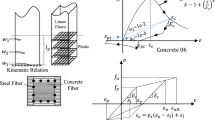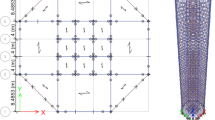Abstract
Earthquake investigations have illustrated that even code-compliant reinforced concrete frames may suffer from soft-story mechanism. This damage mode results in poor ductility and limited energy dissipation. Continuous components offer alternatives that may avoid such failures. A novel infilled rocking wall frame system is proposed that takes advantage of continuous component and rocking characteristics. Previous studies have investigated similar systems that combine a reinforced concrete frame and a wall with rocking behavior used. However, a large-scale experimental study of a reinforced concrete frame combined with a rocking wall has not been reported. In this study, a seismic performance evaluation of the newly proposed infilled rocking wall frame structure was conducted through quasi-static cyclic testing. Critical joints were designed and verified. Numerical models were established and calibrated to estimate frame shear forces. The results evaluation demonstrate that an infilled rocking wall frame can effectively avoid soft-story mechanisms. Capacity and initial stiffness are greatly improved and self-centering behavior is achieved with the help of the infilled rocking wall. Drift distribution becomes more uniform with height. Concrete cracks and damage occurs in desired areas. The infilled rocking wall frame offers a promising approach to achieving seismic resilience.
Similar content being viewed by others
References
ACI Committee 318 (2008), Building Code Requirements for Structural Concrete (ACI 318-08) and Commentary (ACI 318R-08), American Concrete Institute, Farmington Hills, MI.
Alavi B and Krawinkler H (2004), “Strengthening of Moment-resisting Frame Structures Against Near-Fault Ground Motion Effects,” Earthquake Engineering & Structural Dynamics, 33(6): 707–722.
Bruneau M, Chang SE, Eguchi RT, Lee GC, O’Rourke TD, Reinhorn AM, Shinozuka M, Tierney K, Wallace WA and Winterfeldt Dv (2003), “A Framework to Quantitatively Assess and Enhance the Seismic Resilience of Communities,” Earthquake Spectra, 19(4): 733–752.
CEN (2004), Eurocode 2-Design of Concrete Structures Part 1-1: General Rules and Rules for Buildings, EN-1992-1-1:2004 E, Comite Europeen de Normalization, Brussels, Belgium.
Doǧangün A (2004), “Performance of Reinforced Concrete Buildings during the May 1, 2003 Bingöl Earthquake in Turkey,” Engineering Structures, 26(6): 841–856.
GB50010-2010 (2010), Code for Concrete Design of Structure, Beijing: China Building Industry Press. (in Chinese)
GB50011-2010 (2010), Code for Seismic Design of Buildings, Beijing: China Building Industry Press. (in Chinese)
Goulet CA, Haselton CB, Mitrani-Reiser J, Beck JL, Deierlein GG, Porter KA and Stewart JP (2007), “Evaluation of the Seismic Performance of a Code-Conforming Reinforced-concrete Frame Building— from Seismic Hazard to Collapse Safety and Economic Losses,” Earthquake Engineering & Structural Dynamics, 36(13): 1973–1997.
Haselton CB, Liel AB, Deierlein GG, Dean BS and Chou JH (2010), “Seismic Collapse Safety of Reinforced Concrete Buildings. I: Assessment of Ductile Moment Frames,” Journal of Structural Engineering, 137(4): 481–491.
Mazzoni S, McKenna F, Scott MH and Fenves GL (2006), OpenSees Command Language Manual, Pacific Earthquake Engineering Research (PEER) Center.
Pan P, Wu SJ and Nie X (2015), “A Distributed Parameter Model of a Frame Pin-Supported Wall Structure,” Earthquake Engineering & Structural Dynamics, 44(10): 1643–1659.
Pan P, Zhao G, Lu XZ and Deng KL (2014), “Force–Displacement Mixed Control for Collapse Tests of Multistory Buildings Using Quasi-static Loading Systems,” Earthquake Engineering & Structural Dynamics, 43(2): 287–300.
Qu Z, Wada A, Motoyui S, Sakata H and Kishiki S (2012), “Pin-Supported Walls for Enhancing the Seismic Performance of Building Structures,” Earthquake Engineering & Structural Dynamics, 41(14): 2075–2091.
Saatcioglu M and Razvi SR (1992), “Strength and Ductility of Confined Concrete,” Journal of Structural Engineering, 118(6): 1590–1607.
Zhao B, Taucer F and Rossetto T (2009), “Field Investigation on the Performance of Building Structures during the 12 May 2008 Wenchuan Earthquake in China,” Engineering Structures, 31(8): 1707–1723.
Zibaei H and Mokari J (2014), “Evaluation of Seismic Behavior Improvement in RC MRFs Retrofitted by Controlled Rocking Wall Systems,” The Structural Design of Tall and Special Buildings, 23(13): 995–1006.
Acknowledgment
The authors gratefully acknowledge the financial support of the Natural Science Foundation of China under Grant No. 51178342 and 51578314.
Author information
Authors and Affiliations
Corresponding author
Additional information
Supported by: Natural Science Foundation of China under Grant Nos. 51178342 and 51578314
Rights and permissions
About this article
Cite this article
Pan, P., Wu, S., Wang, H. et al. Seismic performance evaluation of an infilled rocking wall frame structure through quasi-static cyclic testing. Earthq. Eng. Eng. Vib. 17, 371–383 (2018). https://doi.org/10.1007/s11803-018-0447-8
Received:
Accepted:
Published:
Issue Date:
DOI: https://doi.org/10.1007/s11803-018-0447-8




